6.4 Timber and concrete upper floors
SCOPE
This Chapter gives guidance on meeting the Technical Requirements and recommendations for the construction of timber and concrete upper floors.
DESIGN STANDARDS
Design that follows the guidance below will be acceptable for timber and concrete upper floors.
STATUTORY REQUIREMENTS
Design should be in accordance with relevant Building Regulations and other statutory requirements.
UPPER FLOOR DESIGN
Items to be taken into account include:
(a) dead and imposed loads
The dead loads should include the weight of the following:
- floor structure, decking and finishes
- ceilings and applied finishes
- walls and partitions supported by the floor
- permanent fixtures such as boilers, water tanks, etc.
Imposed loads are the variable loads imposed when the building is in use. They include the weight of furniture and people. BS EN 1991-1-1 recommends an imposed loading allowance of 1.5kN/m2 for self contained dwellings.
Where the design includes communal areas serving flats or maisonettes, refer to BS EN 1991-1-1 for recommended imposed loads.
Information concerning balconies is given in Chapter 7.1 'Flat roofs and balconies' (Design and Sitework).
(b) supporting structure
The floor structure should have an adequate bearing on the supporting structure. Timber joists should normally have a minimum bearing as shown in the table.
| Type of timber joist |
Minimum bearing [mm] |
|
| End support | Intermediate support | |
| Solid joist on masonry walls |
90 (75) | 90 (75) |
| Solid joist on timber wall plate |
75 | 75 |
| I-joist | 90 (45) | 90 |
| Metal web joist | 90 (75) | 90 |
Note
Figures in brackets should only be used when the joist is not providing restraint to the wall.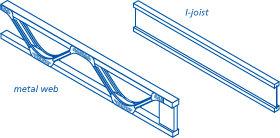
The support reaction due to dead and imposed loads on the floor should not exceed the recommended value specified by the manufacturers of I-joists and metal web joists.
Where necessary, I-joists should have web stiffeners at the locations of concentrated loads in accordance with the manufacturer's recommendations.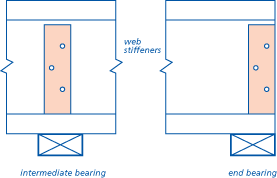
Metal web joists should have uprights at the supports between the flanges held in place by punched metal plate fasteners. Other support options are either top or bottom chord (flange) support, designed by the manufacturer.
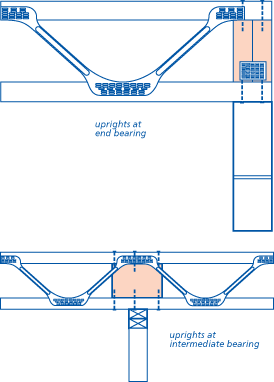
Joists may be supported on joist hangers or on internal load bearing walls. Where permitted they may be built into the inner leaf of an external cavity wall. Where joists are built into the inner leaf care should be taken to ensure air-tightness. Where solid timber joists are built into solid external walls, they should be pre-treated with preservative in accordance with Chapter 2.3 'Timber preservation (natural solid timber)' (Design). I-joists and metal web joists should not be built into solid external walls.
Concrete floors should normally have a minimum bearing of 90mm on masonry walls.
TIMBER FLOOR JOISTS
Items to be taken into account include:
Structural timber for solid joists is normally specified as strength Class C16 or C24. Tables giving the permitted clear span for joists of strength Class C16 and C24 are given in the TRADA Technology Ltd publication "Span tables for solid timber members in floors, ceilings and roofs (excluding trussed rafter roofs) for dwellings" reproduced in Appendix 6.4-A.
I-joists and metal web joists should be specified in accordance with the manufacturer's instructions and the following deflection limits based on total dead and imposed loads for combined bending and shear; 0.003 times the span with a maximum deflection of 14mm if strutting is provided or 12mm if strutting is not provided.
I-joists and metal web joists should not be used in situations where any part of the joist is exposed to external conditions.
Solid timber joist sizes are given in the span tables in BS 8103-3. Where the tables do not apply or where there are concentrated loads, floor joists should be designed by an Engineer in accordance with Technical Requirement R5.
Regularised timber is recommended for floor joists. The section sizes in the tables reproduced in Appendix 6.4-A should be regularised, or be ALS or CLS to enable floors and ceilings to be level.
I-joists and metal web joists should be specified in accordance with manufacturers' instructions.
Joists should not be spaced at centres greater than 600mm.
When planning joist spacings, a clearance of 25mm to 75mm between the first joist and the wall face should be allowed. This helps when installing services and fixing floorboards.
Multiple solid timber joists supporting lightweight non-loadbearing partitions running parallel to the joists should be suitably fixed together (see Sitework clause 6.4 - S7).
I-joists and metal web joists should either:
- be positioned centrally below a non-loadbearing partition (if necessary they can be doubled or tripled up in accordance with the manufacturer's instructions), or
- support the weight of the non-loadbearing partition by noggings or bearers to the two adjacent joists. Unless designed otherwise the noggings should not be less than 38 x 90mm at 600mm centres and fixed with metal clips. The sole plate of the non-loadbearing partition should be fixed to the noggings.
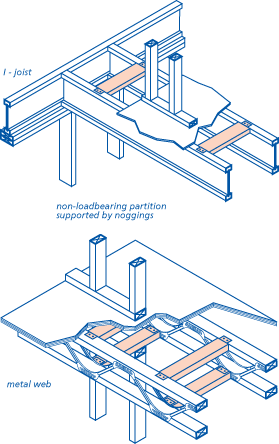
Where first floor masonry partitions cannot be built over ground floor masonry walls, steel or reinforced concrete beams should be specified to support the partition to avoid the effects of shrinkage and long term deflection which can occur with timber beams. It is not acceptable to support masonry partitions on joists unless they are designed by an Engineer in accordance with Technical Requirement R5.
Bearers or additional joists should be specified under heavy loads. Where I-joists and metal web joists are used refer to the manufacturer's detail.
Timber adjacent to heat sources, such as flues, boilers and hot water cylinders, is more susceptible to drying shrinkage. Structural softwood for internal use should be dry graded to BS 4978 (incorporating BS EN 518) or BS EN 519 and marked 'DRY' or 'KD'.
TRIMMER JOISTS
Trimmed openings may be needed around staircase openings and chimneys. Solid trimmed joists may be supported using either:
- joist hangers
- notches
- support battens (light loading only)
- tusked tenon joints.
I-joists and metal web trimmed joists may be supported using joist hangers. If an I-joist is used as a trimmer to support another I-joist, backer blocks should be provided on both sides of the web of the trimmer.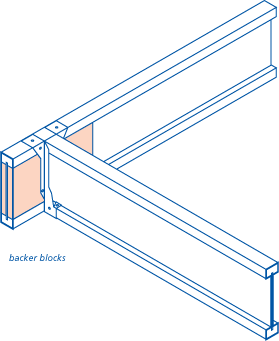
If a metal web joist is used as a trimming joist to support another metal web joist, timber uprights should be provided between the flanges of the trimmer.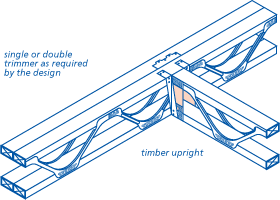
Trimmed openings should be designed in accordance with Technical Requirement R5 or other authoritative guidance.
Further information concerning staircases is given in Chapter 6.6 'Staircases' (Design and Sitework).
STRUTTING OF FLOOR JOISTS
Herringbone strutting or blocking should be provided at the ends of solid joists where they:
- bear onto steelwork
- bear onto intermediate walls
- are supported on joist hangers.
Where solid joists span over 2.5m additional strutting should also be specified as follows:
| Joist span [m] | Rows of strutting |
| Under 2.5 | none needed |
| 2.5 to 4.5 | 1 (at centre of span) |
| Over 4.5 | 2 (at equal spacing) |
Herringbone strutting should be used whenever possible as blocking can be affected by shrinkage of both blocking and joists.
Metal strutting systems are also acceptable for solid joists if assessed in accordance with Technical Requirement R3.
Where required, strutting for I-joists should be provided in accordance with the table above.
Where required, strutting for metal web joists should be in accordance with the following table;
| Joist span [m] | Rows of bracing |
| 4.0 to 8.0 | 1 (at centre of span) |
| Over 8.0 | 2 (at equal spacing) |
For metal web joists, bracing (strongbacks) should be provided.
JOIST HANGERS
For solid timber joists the hanger should be the full depth of the joists.
For I-joists:
- the hanger should be the full depth of the joists and restrain the top flange, or
- be at least 0.6 x the depth of the joist and full depth stiffeners should be fixed to both sides of the web.
For metal web joists:
- the hanger should be the full depth of the joist and restrain the top flange or,
- top flange restraint should be provided (see Sitework clause 6.4-S4).
A timber upright should be fixed between the flanges of metal web joists.
Joist hangers should meet with the requirements of BS EN 845-1 or be assessed in accordance with Technical Requirement R3. The manufacturers of I-joists and metal web joists should be consulted about joist hangers suitable for their range of products.
If low strength masonry is used, the loading on the top flange of the joist hanger should not be greater than the strength of the supporting masonry.
The design should detail the type of support to be used for joists, trimmers and trimming joists.
The minimum bearing for joists on hangers should be as follows:
| Type of timber joist | Minimum bearing [mm] |
| Solid joist | 75 |
| I-joist | 45 |
| Metal web joist | 75 |
The minimum bearing for hangers on masonry should be 75mm.
JOIST SUPPORT AT SEPARATING WALLS
Joists built into separating walls may provide lateral support but it can conflict with sound insulation and fire resistance requirements in England & Wales.
In Scotland joists should not be built into separating walls.
RESTRAINT STRAPS
Restraint straps and/or joist hangers suitable for taking tensile forces may be required to tie the walls and upper floors together. Restraint straps at not more than 2m centres should be provided along the walls that run parallel to the joists.
BS 8103-1 gives details of the connections between structural elements.
The position and size of restraint straps should be shown on drawings.
Where joists are supported on hangers restraint straps along the direction of the joists at not more than 2m centres are required. In buildings of not more than two storeys where restraint type joist hangers, assessed in accordance with Technical Requirement R3 are used or where joists are built into a wall and bear at least 90mm on the wall no restraint straps are required along the joists.
STRUCTURAL STEELWORK IN FLOORS
Structural steelwork should be in accordance with Chapter 6.5 'Steelwork support to upper floors and partitions' (each section), or should be designed by an Engineer in accordance with Technical Requirement R5.
Where steelwork supports solid timber joists, the depth of the timber joists should be such that they can be notched and have 12mm/2mm projections to allow for shrinkage of the timber.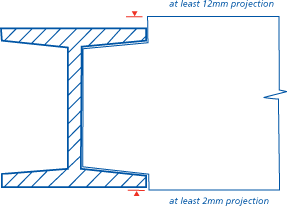
Structural continuity of the floor should be provided by the use of continuous decking fixed to joists on both sides of a transverse steel joist.
Steel sizes should allow adequate bearing for timber joists, where required.
Where steelwork supports I-joists, the joists may bear directly into the steel beam if there is at least 45mm bearing on the bottom flange of the steel beam. Noggings (38mm x thickness of flange) should be provided at the top and bottom flanges of the I-joists. If the bearing is less than 45mm timber blocking should be fixed to the steel beam to enable the I-joists to be face fixed using joist hangers to the blocking inside the steel beam.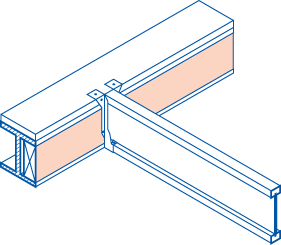
Flanges of metal web joists should not be notched. Joists can bear directly into the steel beam if there is at least 75mm bearing on the bottom flange of the steel beam. Timber uprights should be provided between the flanges and 38mm x 97mm noggings should be provided between the uprights. If the bearing is less than 75mm metal web joists can be supported on their top flange and their bottom flange should be fixed to timber blocking supported on the inside of the steel beam.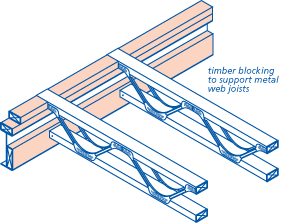
FIRE SPREAD
All floors should have the fire resistance required by the relevant Building Regulations.
I-joists and metal web joists may require a different specification for the ceiling than that for solid timber joists to achieve the same fire resistance.
Ceilings should not be perforated (e.g. for downlighters) unless it can be shown that the floor construction achieves the required fire resistance.
Combustible material should be kept away from heat sources as described in Chapter 6.8 'Fireplaces, chimneys and flues' (Design and Sitework). In particular, structural timber should be at least 40mm from the outer surface of a masonry chimney or fireplace recess. Floorboards may be closer than 40mm from the chimney wall.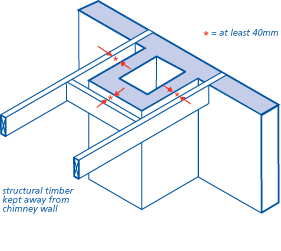
FLOOR DECKING
Items to be taken into account include:
(a) decking and joist centres
The correct thickness of decking should be specified for the joist centres used. Thicknesses should be not less than those shown in this table for normal domestic loads, i.e. an imposed load of 1.5kN/m2.
| Thickness of decking [mm] |
|||
| Joist centres |
|||
| 400mm | 450mm | 600mm | |
| T and G softwood boarding | 16 | 16 | 19 |
| Chipboard | 18 | 18 | 22 |
| Plywood | 12 | 12 | 16 |
| Oriented strand board | 15 | 15 | 18/19 |
Note
Oriented strand board should be laid with the stronger axis at right angles to the supports. Other decking materials not listed in the table should comply with Technical Requirement R3. The above thicknesses may not be adequate to achieve a mass for floor decking of 15 kg/m2 for sound insulation requirements of floors in England & Wales.
(b) resistance to moisture
Chipboard for flooring should be moisture-resistant flooring Type P5 to BS EN 312 throughout the dwelling. Oriented strand board should be Type OSB3 to BS EN 300.
(c) fixing
Adequate support and correct fixings should be specified in accordance with the manufacturer's recommendations. All butt joints should be supported by joists or noggings. Nail length should be 2½ times the thickness of the decking material.
Some decking materials require their joints to be glued together and glued to joists (see Sitework clauses 6.4 - S19 and S20).
(d) sound insulation
Where the floor decking contributes to the sound insulation of a floor within a dwelling, the thickness of the decking given in (a) above may not achieve a mass of 15 kg/m2. Alternatively the floor construction may have been tested to show adequacy.
CONCRETE FLOORS
Design should be in accordance with Clause D3.
Design of in-situ or precast concrete floors should be in accordance with BS EN 1992-1-1 and Technical Requirement R5. Proprietary concrete elements will be acceptable, if assessed in accordance with Technical Requirement R3.
FLOORS IN AND BETWEEN DWELLINGS
Materials and constructions should comply with Technical Requirement R3 and statutory requirements.
Materials and constructions should comply with Technical Requirement R3 and with statutory requirements.
PROVISION OF INFORMATION
The design should ensure compatibility with other drawings, especially with respect to services.
For upper floors, the drawings should show:
- direction of floor span and size and spacing of joists or concrete components
- size of trimmers and trimming joists
- position of strutting
- openings in the floor
- supporting walls below
- walls and partitions above
- positions of restraint straps
- positions of large service penetrations, eg chimneys, SVPs
- position of insulation
- details at all junctions.
Ensure that design and specification information is issued to site supervisors and relevant specialist subcontractors and/or suppliers.
Where proprietary components are to be used, manufacturers may have specific requirements for fixing and/or assembly of their products. This information should also be made available for reference on site so that work can be carried out satisfactorily, in accordance with the design and specification.





















